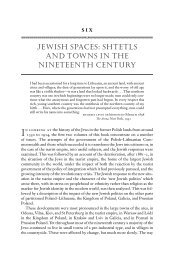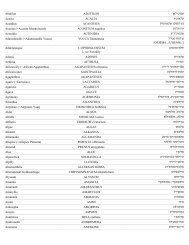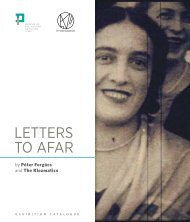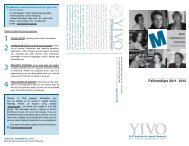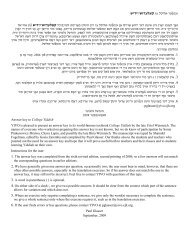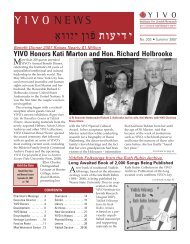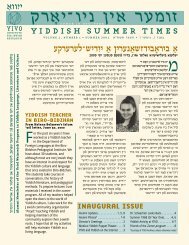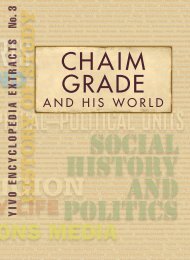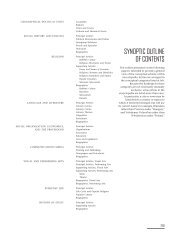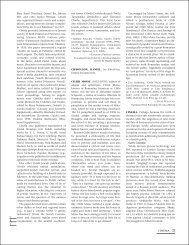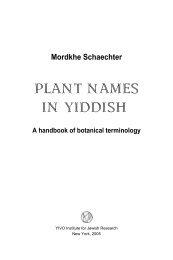Hebrew literature - YIVO Institute for Jewish Research
Hebrew literature - YIVO Institute for Jewish Research
Hebrew literature - YIVO Institute for Jewish Research
Create successful ePaper yourself
Turn your PDF publications into a flip-book with our unique Google optimized e-Paper software.
S<br />
R<br />
L<br />
Frontispiece of the first issue of Keneset Yisra’el. Warsaw, 1887. (Gross Family Collection)<br />
among these journals were Kaveret (1890),<br />
Pardes (1892), LuaÕ AÕi’asaf (1893), Mi-<br />
MizraÕ umi-ma‘arav (1894), and Ha-<br />
ShiloaÕ (1896).<br />
The founding of the AÕi’asaf publishing<br />
company in 1893 signified the modernization<br />
of <strong>Hebrew</strong> publishing. Three<br />
years later, the Tushiyah publishing house<br />
was founded in Warsaw. For the next 15<br />
years, it was to serve as the central plat<strong>for</strong>m<br />
and generating <strong>for</strong>ce behind <strong>Hebrew</strong><br />
<strong>literature</strong> in all its <strong>for</strong>ms. Among<br />
the guiding principles of AÕi’asaf, and<br />
of Tushiyah—while under the management<br />
of Ben-Avigdor—were the following:<br />
selecting manuscripts; paying writer’s<br />
salaries, developing subscription book series;<br />
promoting young writers; and<br />
monitoring advertising and distribution.<br />
Formulated from a farsighted national<br />
and cultural perspective, these principles<br />
signaled the birth of commercial <strong>Hebrew</strong><br />
publishing.<br />
The period also witnessed the expansion<br />
of <strong>Hebrew</strong> children’s <strong>literature</strong>, a direct<br />
result of the activities and vision of<br />
the Ôibat Tsiyon movement and its ef<strong>for</strong>t<br />
to nurture future generations of readers of<br />
<strong>Hebrew</strong> <strong>literature</strong>. Aside from anthologies<br />
and textbooks, there were also children’s<br />
newspapers, such as ‘Olam katan and Gan<br />
sha‘ashu‘im.<br />
The principal centers of <strong>Hebrew</strong> <strong>literature</strong><br />
within the Russian Empire were<br />
Odessa (home to Mendele, Ahad Ha-Am,<br />
Yehoshu‘a Ôana Ravnitski, E. L. Lewinsky,<br />
and Bialik) and Warsaw (home to Frishman,<br />
Sokolow, Ben-Avigdor, and Peretz).<br />
Warsaw was the location of the dynamic<br />
literary market—including printers, publishing<br />
companies, and newspaper editorial<br />
staffs. In addition to these two main<br />
centers, there was some literary activity<br />
in other European cities (Vilna, Lwów, Vienna,<br />
Berlin, and London) and overseas<br />
(mainly the United States and Palestine),<br />
with a rich network linking main centers<br />
to their satellites.<br />
The dynamic vitality that characterized<br />
the final decades of the nineteenth century—especially<br />
in the 1890s—resulted in<br />
a series of literary and ideological polemics<br />
from which emerged the concept of<br />
secular <strong>Hebrew</strong> culture as an offshoot and<br />
objective of the Zionist revolution. These<br />
included debates over the literary realism<br />
of the New Way; the objectives of a national<br />
culture stimulated by the founding<br />
of the monthly Ha-ShiloaÕ; and the role<br />
of culture—all topics that dominated the<br />
first Zionist congresses. These illustrative<br />
examples of the dynamics of literary debates<br />
being conducted in Eastern Europe<br />
set the tone <strong>for</strong> modernism’s emergence<br />
in <strong>Hebrew</strong> <strong>literature</strong> at the turn of the<br />
twentieth century.<br />
The Early Twentieth Century<br />
In the first two decades of the twentieth<br />
century, <strong>Hebrew</strong> <strong>literature</strong> in Eastern Europe<br />
produced its best examples of poetry,<br />
fiction, essays, and literary criticism.<br />
The combination of great writers, an increasingly<br />
sophisticated means of expression,<br />
a greater attentiveness to the trends<br />
of European <strong>literature</strong>, a wide array of<br />
publishing options, and a stable reading<br />
public that turned to <strong>Hebrew</strong> <strong>literature</strong><br />
<strong>for</strong> spiritual nourishment resulted in the<br />
establishment of a genuine <strong>Hebrew</strong> literary<br />
system. However, this growth in literary<br />
activity was interrupted by two<br />
major crises—the first Russian Revolution<br />
(1905–1907), and World War I (1914–<br />
1918)—that permanently halted most<br />
<strong>Hebrew</strong> publishing. Although the Second<br />
Aliyah (1904–1914) attracted many writers<br />
to Palestine, holding out the prospect<br />
of a <strong>Hebrew</strong> literary center in the land of<br />
Israel, it remained largely dependent upon<br />
the production and distribution systems<br />
of Russia and Poland, with the majority<br />
of readers still based in Eastern Europe.<br />
Prose fiction of this period was dominated<br />
by realism, although one could also<br />
HEBREW LITERATURE 701



